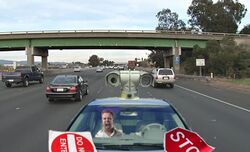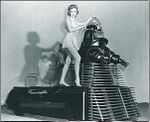Autonomous vehicle
Autonomous vehicles (or AVs) are cars and trucks that use computers to drive themselves. They have autonomy — that is, a mind of their own — independent of the driver or owner of the car. Nevertheless, they can usually be counted on to pursue an itinerary that is suitable to the driver/owner.
History[edit]
The AV was preceded, at Detroit car manufacturers, by the EV. This was an effort to build a car without burning fossil fuels. EVs were sold as having no visible pollution at all; their lack of a tailpipe was clear proof. All the pollution, in fact, was done at the coal-fired power plant over at the coast, and the manufacturing plant, where it was invisible. However, when it became time to fork over cash to replace a ton of lead-acid batteries after only 20,000 miles of driving, there was often visible pollution in the form of black smoke coming out of the owners' ears.
Detroit turned its attention to other innovations that might improve driving without tossing the entire power train overboard; foremost, better information for the driver. In the 2000s, GPS devices such as Garmin and TomTom took advantage of precise global positioning (or deliberately imprecise positioning, for civilians) and gave the driver a colorful new gadget to look at instead of the road. A few years later, the cellphone and the tablet provided several more screens to amuse the driver, and that was even before the wide availability of pornography in the driver's seat.
By the 2010s, these devices were customizable so that the driver could specify whether to restrict the recommended route to those that had a road under them. This advance virtually eliminated drivers in New York City following their devices' orders and plunging into the East River.
As Detroit approached the 2020s, the focus became not just to give the driver better information but to cut him out of the picture entirely. An example of this changed focus was the Boeing 737-MAX where, rather than teach pilots that the engines had moved forward and they could stall the jet if they tried to climb too fast, a sophisticated computer simply took over the joystick and pushed it forward so that the plane went down instead. By all accounts, this system was perfect at guiding planes downward, until the model was pulled from the market entirely in 2019.
The automotive industry immediately saw the benefit of computerized control of large masses of metal and sought to replicate it in their products. With the assistance of major players in the mobile phone industry, "hands free" technology was developed. No longer did drivers have to keep both hands on the wheel, they just instructed their cars what to do, and how to do it. This turned out to be about as effective as "the clapper" in turning lights on and off reliably in a house with a dog [1] It also gave insurance companies and law enforcement free reign of the microphones conveniently built into the cars, making radar guns obsolete, and giving advance warnings of crimes before they were committed.
Eventually, with the assistance of expert programmers from the biggest names in the computer industries, Artificial Intelligence (AI) was developed to allow cars to drive themselves. Parallel parking, turns, acceleration, braking, backing, the AI could do all of this by itself. It could even start its own engine, and drive from one specified starting point to a destination point. What could go wrong?
Early efforts[edit]
Early AV prototypes were integrated into military tanks, that had clumsy sensor clusters at the front of the vehicle. This was supposed to tell the prototype what type of hazard this was. It had three settings: Animal, mineral or vegetable. In addition, a flashing sensor and siren and a bright red paint scheme, was to tell everyone that a perfect noob with tons of steel armor was on the move. Several decades later, this technology would evolve into flying drones with remote control.
Later designs were improved by NASA through field testing. Amongst the earliest vehicles fitted with these sensors was on various missions to Mars with their roaming buggies zig-zagging across the Martian deserts. All eventually fell quiet. The official message to the press was that the Mars Exploration Rovers had run out of battery juice and/or had fallen into hidden caves. Later data suggested they had been vandalised by irritated locals who were against Earthlings measuring out their planet for real estate deals.
Controversy[edit]
Not everyone is keen to see these autonomous vehicles. An alliance of boy racers, speed demons and taxi drivers object violently that their way of being is about to go as obsolete as the horse and cart. Others fear that the government will take control of navigation and make it impossible if it detects you are heading to a forbidden zone.
Others argue that these autonomous vehicles do not do enough. They cannot detect construction barrels, barricades, large shooting ranges, minefields, or airport landing strips, and they do not fly. Snouts, wings, and tails are reported to be in development for these vehicles however.
The future[edit]
Amazon does not yet have an entry in the AV market, but certainly will soon. Jeff Bezos' original vision for Amazon was, after all, to use artificial intelligence (AI) to "build a machine that knows what you want before you do"; that is, to analyze your purchases and saddle you with more stuff that you will not quite be moved to ship back for a refund. With a shipping charge, of course. The machine of course listens to exactly what you want. Prescriptions, subscriptions, what's the difference? On the other hand, AI makes the perfect audience for carpool karaoke, since it does not care whether you sing on key, off key, or forgot most of the lyrics that are not being displayed on a screen.
Consequently, it should be child's play for Amazon to build you a car that "knows where you want to go before you do." This might include analyzing your movements and conversations, trying to drive you to a closed business, taking shortcuts through the wrong side of town, and taking you to visit friends and acquaintances that were not expecting you and might be dining but will barely be unmotivated to slam the door in your face when you arrive or tell you to piss off.
Notes[edit]
- ↑ Arf arf, arf arf. Woof woof woof woof, Arf arf arf arf. It turns out dogs liked the jingle too.



